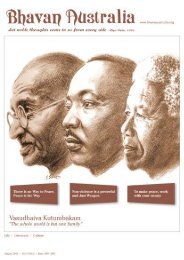Issue 8.5 - Bharatiya Vidya Bhavan Australia
Issue 8.5 - Bharatiya Vidya Bhavan Australia
Issue 8.5 - Bharatiya Vidya Bhavan Australia
You also want an ePaper? Increase the reach of your titles
YUMPU automatically turns print PDFs into web optimized ePapers that Google loves.
Building the India-US Partnership<br />
Washington, DC: President Barack Obama’s first<br />
presidential visit to India offers a unique<br />
opportunity to cement a global partnership with a<br />
rapidly emerging power. Set to become the world’s<br />
third or fourth largest economy by 2030, India could<br />
become America’s most important strategic partner.<br />
In coming decades, a strong bilateral partnership will<br />
prove vital in managing the rise of China and<br />
promoting an Asian balance of power that is favorable<br />
to India, the United States, and Asia as a whole. India’s<br />
success as a democracy also strengthens freedom<br />
globally and protects broader American interests.<br />
Yet, as many observers have noted, US-India<br />
relations have recently become listless and marked<br />
by drift. Both countries are to blame. Obama has<br />
understandably focused on competing priorities,<br />
including the troubled US economy and ongoing<br />
wars abroad. India’s government has been similarly<br />
occupied with domestic political struggles and the<br />
challenge of sustaining economic growth amid<br />
rising pressure for redistribution. Moreover, Indian<br />
officials must still nurture the small, albeit growing,<br />
constituency that supports a rapidly transformed<br />
relationship with the US.<br />
For its part, the Obama administration should take<br />
a number of steps to reaffirm its support for India’s<br />
rise, its democratic achievements, and its struggle<br />
for security. Notably, the US should reaffirm its<br />
support for a larger Indian role in international<br />
organizations and help integrate India into the<br />
global non-proliferation regime.<br />
In this context, the Obama administration should<br />
endorse India’s quest for a permanent seat on the<br />
United Nations Security Council. Obama<br />
48 | <strong>Bhavan</strong> <strong>Australia</strong> | Nov 2010<br />
should also support India’s membership in key nonproliferation<br />
organizations like the Nuclear Suppliers<br />
Group and the Missile Technology Control Regime.<br />
India, too, must do its part. It can begin by creating<br />
greater opportunities for US firms—including from<br />
the nuclear industry—to invest in India’s economic<br />
success. It can expand defense cooperation beyond<br />
purchases of American-made military equipment by<br />
deepening its diplomatic engagement with the US to<br />
help find solutions to the difficult problems stemming<br />
from Afghanistan, Pakistan, and Iran. In short, India’s<br />
government should look for ways to sustain<br />
America’s interest in India during difficult times.<br />
Both countries should consolidate their<br />
cooperation in other areas already agreed upon:<br />
agriculture, education, health care, energy, and<br />
science and technology. Obama’s trip offers an<br />
opportunity for taking stock, expanding initiatives<br />
that have matured, and announcing new projects<br />
that will provide global benefits.<br />
The latter include developing an international food<br />
security initiative, cooperating to increase<br />
vocational training in fragile states, expanding<br />
clean-energy research, investing in global diseasedetection<br />
systems, and collaborating to explore<br />
shale-gas extraction. In addition, the US and India<br />
should create innovation partnerships, which would<br />
not only yield direct returns to both countries, but<br />
would also demonstrate how a strong bilateral<br />
relationship can improve the international system.<br />
Ultimately, a strong US-Indian partnership is in both<br />
countries’ strategic interest. Their societies are<br />
already intertwined—and will be even more so in<br />
the future—by various personal, economic, and<br />
social links. Moreover, Obama should resist the<br />
urge to approach the bilateral relationship purely<br />
in transactional terms, but instead should seek to<br />
strengthen India’s long-term capacity to be a<br />
productive partner with the US.<br />
In short, Obama ought not to ask, “What will India<br />
do for us?”, but rather, “Is a strong, democratic and<br />
independent India in America’s national interest?” If<br />
the answer to this question is yes—as it should<br />
be—then the US should focus on how it can help<br />
India’s power continue to grow.<br />
Ashley J. Tellis, a Senior Associate at the Carnegie<br />
Endowment for International Peace, helped to<br />
negotiate the US-India civil nuclear agreement. He<br />
is the author of a new report, “Obama in India –<br />
Building a Global Partnership: Challenges, Risks,<br />
Opportunities,” from which this article is adapted.<br />
Copyright: Project Syndicate, 2010.<br />
Source: www.project-syndicate.org









